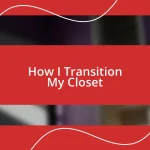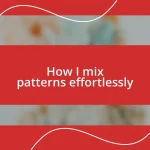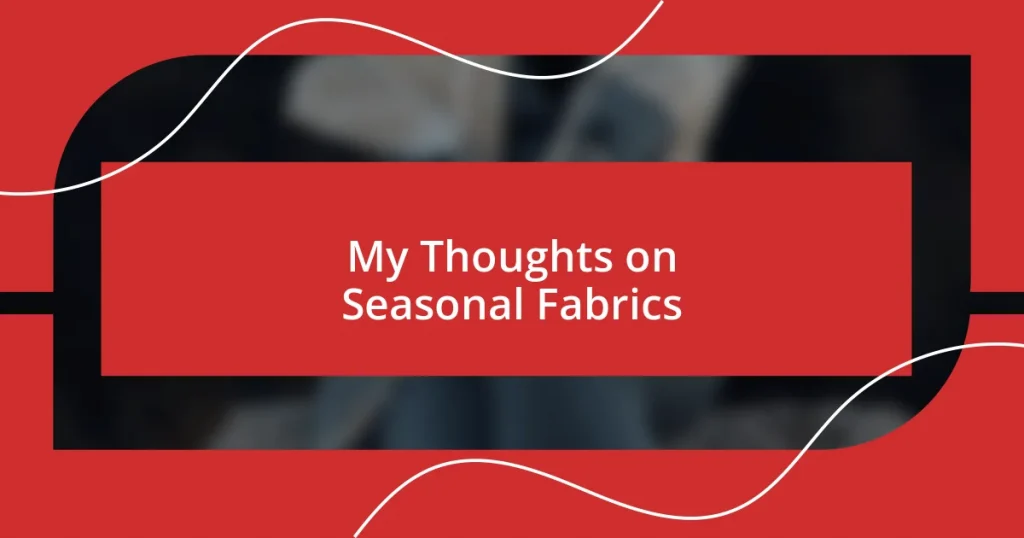Key takeaways:
- A wardrobe audit enhances personal style clarity, allowing individuals to understand their current preferences and let go of items that no longer resonate.
- Organizing clothing by category and color improves accessibility and creativity in outfit selection, turning the closet into a more functional and inspiring space.
- Maintaining wardrobe health through regular checks, mindful shopping, and proper clothing care can prevent overwhelm and prolong the life of garments.

Understanding wardrobe audits benefits
One of the most striking benefits of a wardrobe audit is the clarity it brings to your personal style. I remember when I first tackled my closet; I was amazed at how many pieces still had tags attached. How often do we buy clothing with excitement only to let it languish, forgotten? This realization pushed me to rethink not just what I wear, but why I buy.
A wardrobe audit also helps in understanding what truly fits your life and body. After donating several items that didn’t feel good anymore, I felt a weight lift off my shoulders. It’s empowering to create a space that mirrors your current self rather than your past ideals. Have you ever held on to something because it used to look great but no longer makes you feel confident?
Lastly, the environmental impact of being intentional with your wardrobe can’t be overlooked. By choosing to donate or recycle unused items instead of letting them collect dust, I felt I was doing my part for the planet. How rewarding it is to think that a piece of clothing I no longer wear could still bring joy to someone else! This kind of mindfulness extends beyond just the clothes; it fosters a deeper awareness of consumption in all aspects of life.
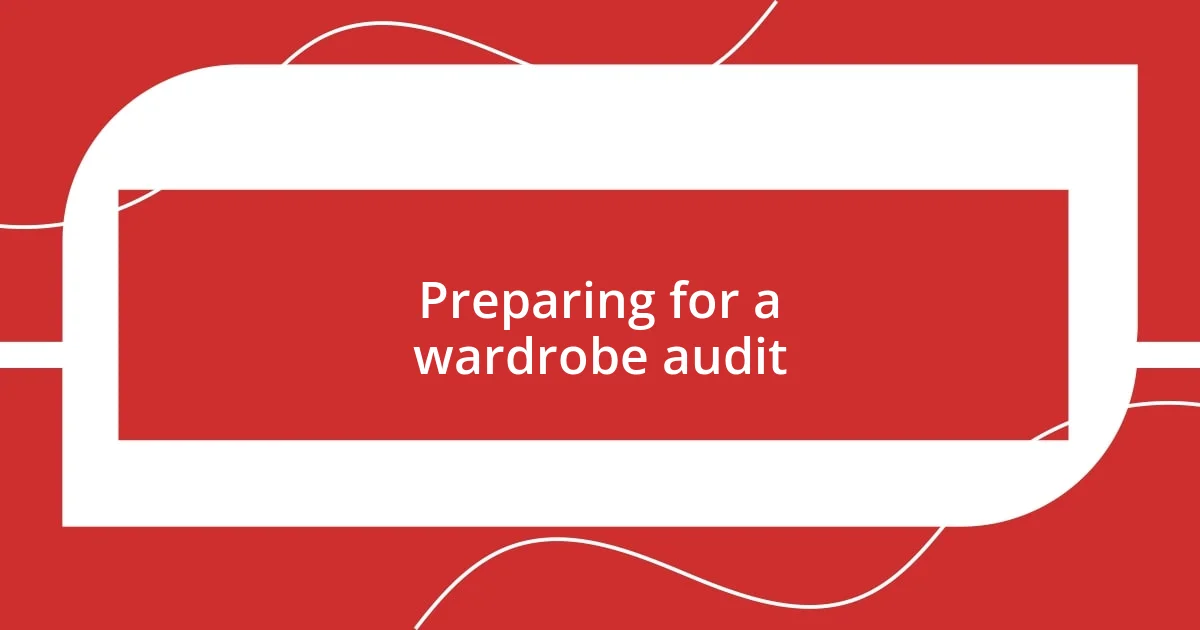
Preparing for a wardrobe audit
Preparing for a wardrobe audit can feel daunting, but with a bit of organization, it can become an enlightening experience. I once thought I could tackle my entire wardrobe in a single afternoon. Spoiler alert: that was a mistake! Instead, I learned the importance of creating a plan, setting aside specific days for each section of my closet. It made the process much more manageable and enjoyable.
Here’s a simple checklist to help you prepare for your wardrobe audit:
- Set a date and time that allows you to focus without distractions.
- Gather supplies: boxes or bags for donations and a notepad for jotting down insights.
- Have a styling buddy if you like the extra motivation and honesty.
- Choose one area to focus on at a time—like shoes one day, tops another.
- Dress comfortably so you can try on pieces easily.
As I went through my shoes, I felt nostalgic about a pair of heels I wore to a memorable date. Yet, holding them sparked a realization: Just because they held good memories didn’t mean they deserved space in my closet. Embracing this mindset helped me make tough decisions, leading to a wardrobe that felt much more true to who I am today.
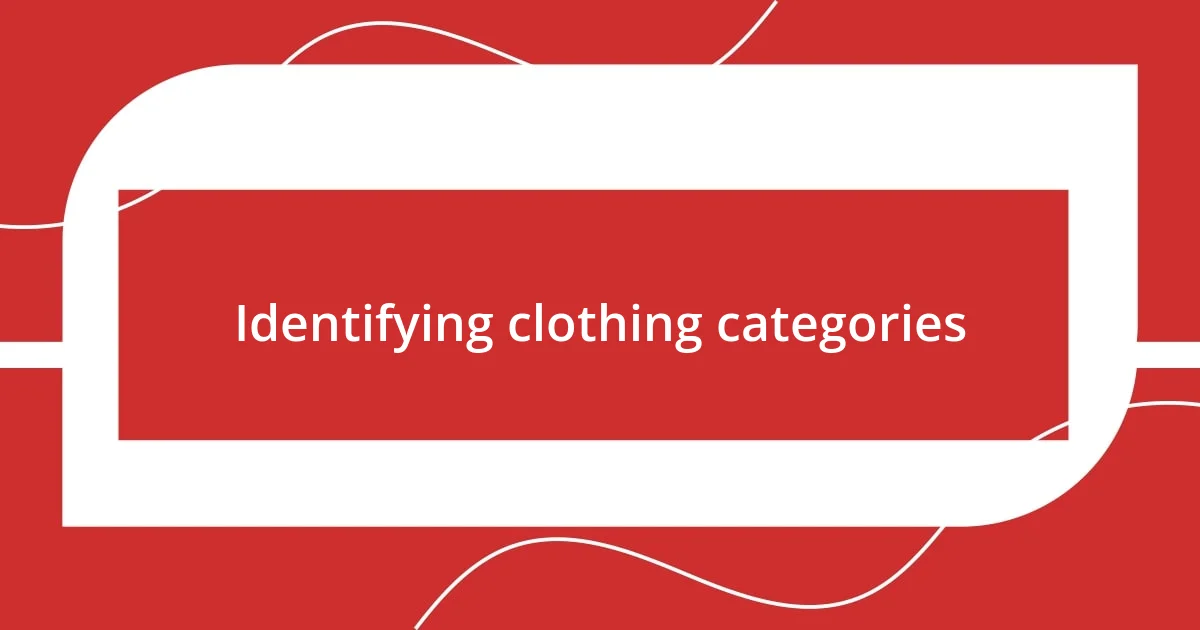
Identifying clothing categories
Identifying clothing categories is a crucial step in a wardrobe audit. I found that grouping similar items together brought a sense of organization and clarity. For instance, separating casual wear from work attire helped me visualize my style choices and made it easier to identify any duplicates or items I truly didn’t love anymore. Have you ever realized you have ten black t-shirts but still feel like you have nothing to wear?
As I sorted through my clothes, I categorized them into three main groups: keep, donate, and repair. The “keep” pile included items that fit well and made me feel confident. I remember holding up a colorful dress from a past summer adventure; it was a reminder of joyful moments, and I couldn’t bear to let it go. Meanwhile, the “donate” pile included pieces I hadn’t worn in ages, like those ill-fitting jeans that never felt right. The “repair” category was eye-opening, too, as it highlighted items that needed just a little love to be wearable again.
Understanding clothing categories transformed my perspective on what I own. It became a journey of self-discovery—what does each piece signify in connection to my life? By the end of my audit, I realized that a cohesive wardrobe not only simplifies getting dressed but also reflects who I am. When I look at my closet now, each category tells a story, and I feel a sense of peace knowing everything has its place.
| Clothing Category | Description |
|---|---|
| Keep | Items that make you feel good and fit well |
| Donate | Pieces you no longer wear or use |
| Repair | Clothing needing fixes to be wearable again |
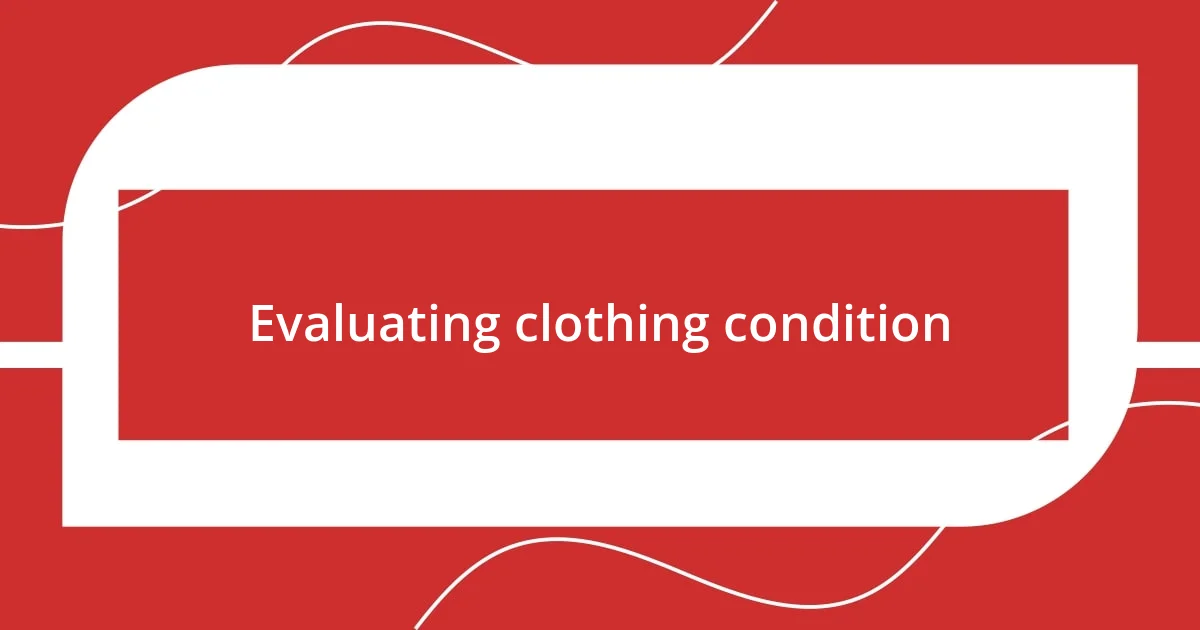
Evaluating clothing condition
Evaluating clothing condition is a pivotal part of my wardrobe audit experience. As I sifted through each garment, I found myself checking for wear and tear—faded colors, missing buttons, or fraying hems. One day, I came across a beloved sweater that had seen better days. It struck me: just because it held sentimental value didn’t mean it deserved a place in my closet anymore.
I remember holding up a pair of jeans that I hadn’t worn in ages. They were a perfect fit once, but the fabric was now noticeably thin and worn out. This realization made me think about the importance of quality over quantity in my wardrobe. How many items had I kept purely out of habit instead of genuine appreciation? I learned to be honest with myself about what was truly worth keeping.
Another insight was recognizing the difference between “vintage charm” and simply being outdated. I found a chic blazer that once made me feel like a million bucks, but the style no longer resonated with who I am today. Whether it’s about personal growth or changing trends, evaluating condition gave me permission to let go of pieces that didn’t reflect my current style. Have you ever looked at a piece of clothing and felt an emotional weight from the past? It’s liberating to understand that letting go is not just about loss, but about making space for what truly represents you.
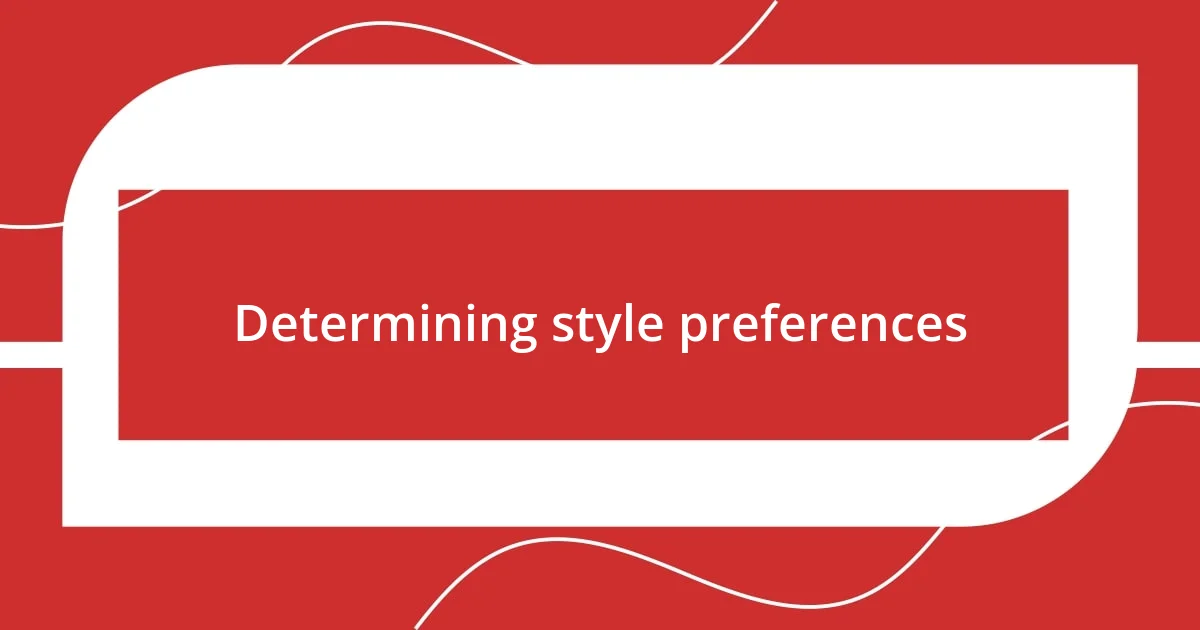
Determining style preferences
Determining style preferences can feel like peeling back layers of your personality. I remember finding myself drawn to bright colors and interesting patterns during my wardrobe audit. It made me realize that my style reflects my vibrant personality more than I had thought. Have you ever noticed how certain pieces just light up your mood when you wear them?
While sorting through my clothes, I came across various items that didn’t quite resonate with me anymore. For example, there was a plain, gray sweater I had held onto for years, thinking it was practical. But when I tried it on, I felt uninspired. This sparked a realization for me: clothing should not only be functional but should also evoke joy. It’s okay to let go of what doesn’t speak to you anymore. Did you ever wonder if your wardrobe truly represents who you are?
Reflecting on my closet led me to understand that my style preferences evolve, influenced by both my personal experiences and current trends. Each time I stepped back and examined what I wore regularly, I saw clear patterns emerging – a love for flowy silhouettes, comfortable fits, and bold statement pieces. Embracing these preferences empowered me, allowing my wardrobe to align more closely with my identity. It feels exciting to articulate fashion choices that genuinely resonate with my current self; don’t you think that creates a much more fulfilling wardrobe?
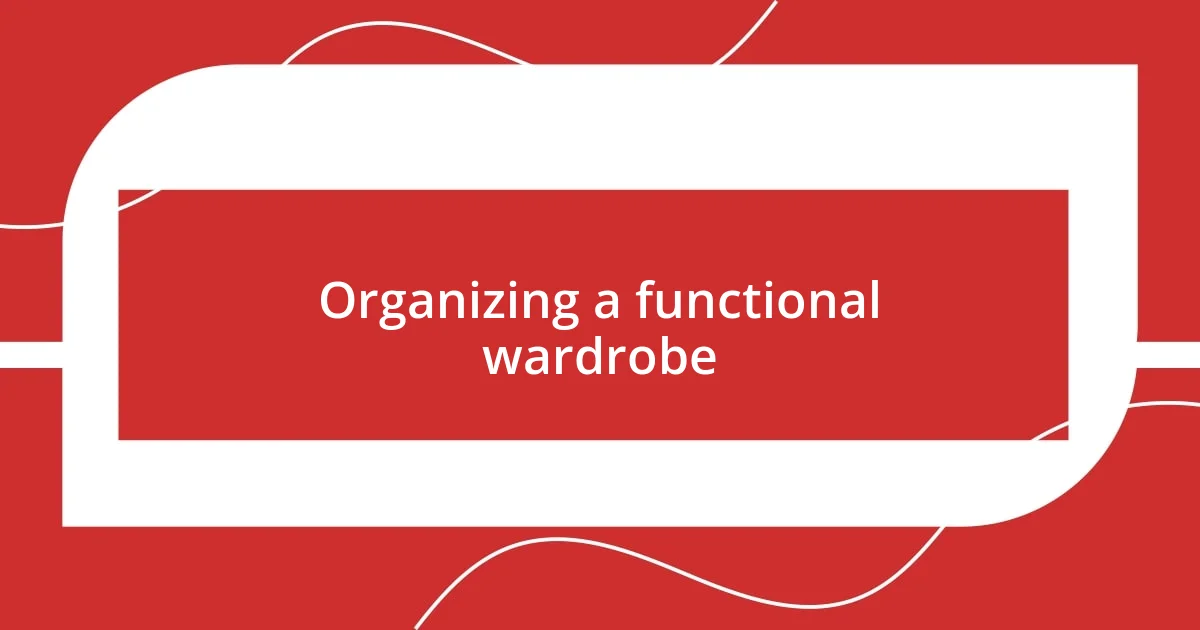
Organizing a functional wardrobe
As I dove into organizing my wardrobe, I learned that a functional closet is all about accessibility. When I arranged my clothes by category—tops, bottoms, and outerwear—I noticed how much easier it became to mix and match outfits. Have you ever found yourself rummaging through a chaotic pile, frustrated because your favorite shirt is buried? Simplifying the organization made getting dressed a joyful, quick experience instead of a daily chore.
Another game-changer for my wardrobe audit was color coordination. I grouped my garments by hues, creating a visual delight that inspired creativity in my outfits. One afternoon, I stood in front of a vibrant rainbow of clothes, and it felt as if each piece beckoned me to explore different combinations. How exhilarating is it to reach for a blouse because it’s not just functional, but it invigorates your senses? This approach turned my closet into a personal gallery rather than just a storage space.
Lastly, I discovered the importance of seasonal rotation. As I meticulously switched out summer and winter clothes, I stumbled upon items I had forgotten I owned—pieces that sparked joy and nostalgia. For instance, rediscovering a unique sundress made me remember sunny beach days and carefree moments. Isn’t it remarkable how a single garment can transport you back in time? Rotating clothes ensures my current selections stay fresh, making my wardrobe not just organized, but also a living reflection of my journey.
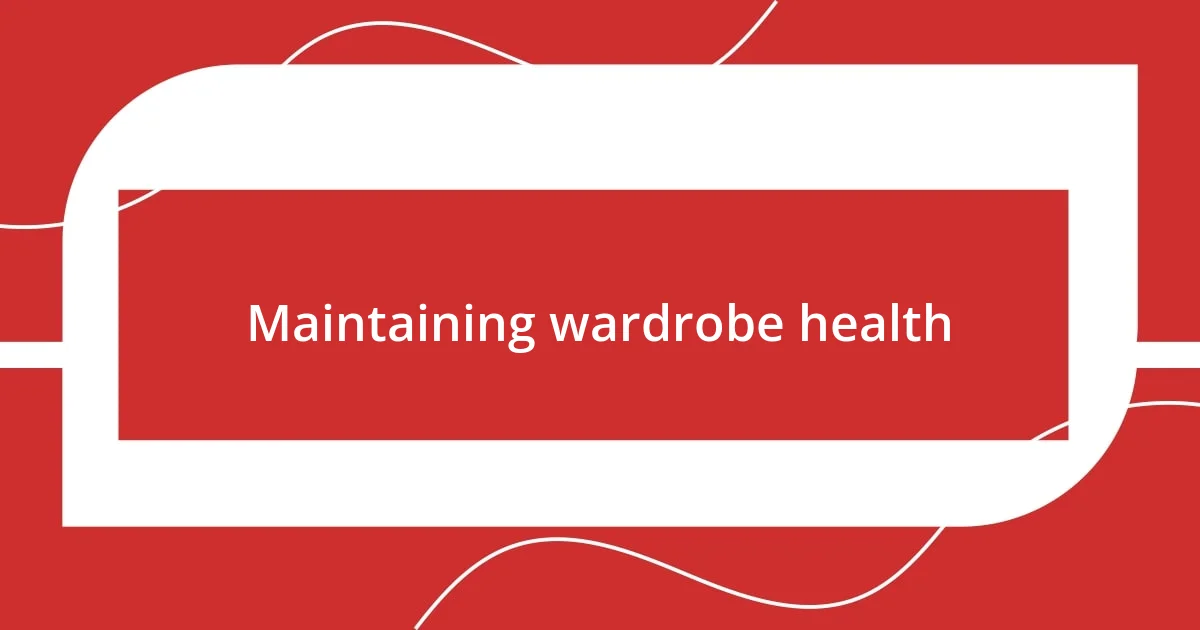
Maintaining wardrobe health
Maintaining wardrobe health is about being proactive with what you own. After my audit, I started an ongoing process of regular checks, dedicating a few minutes each month to assess my pieces. I can’t stress enough how this simple habit can prevent overwhelm later—kind of like getting a regular health check-up, but for your clothes! Have you ever faced that dread of opening your closet only to find it stuffed with outdated items?
I also embraced the idea of mindful shopping to support my wardrobe’s longevity. Now, instead of buying on impulse, I ask myself questions like, “Will this piece work with three outfits I already love?” This practice has not only helped reduce clutter but has also made my purchases more intentional. I recall a time I was tempted by a trendy dress but chose to pass after envisioning it hanging unused. It’s liberating to realize that less can genuinely mean more, right?
Alongside regular audits and thoughtful shopping, I’ve learned the value of clothing care. Simple acts like washing at the right temperature, air-drying, and storing items properly can significantly prolong their life. When I started using cedar blocks in my drawers, I was amazed by how well they helped keep my clothes fresh and protected from moths. Isn’t it fascinating how a little effort goes such a long way in keeping our closet treasures in shape?









